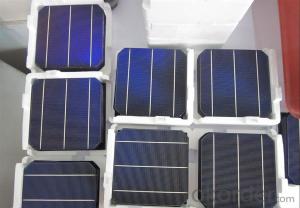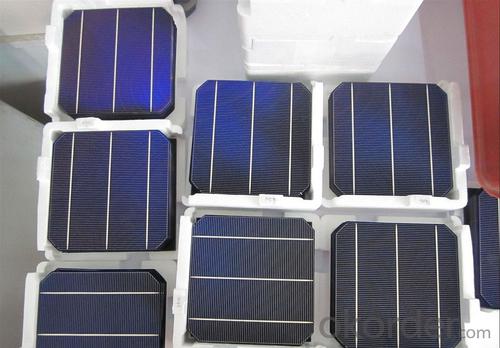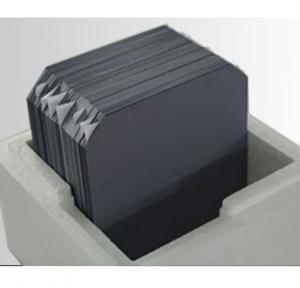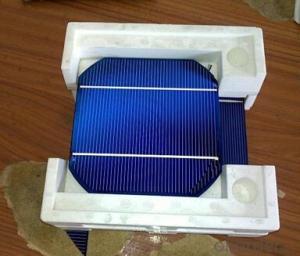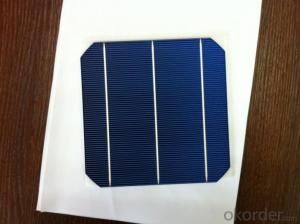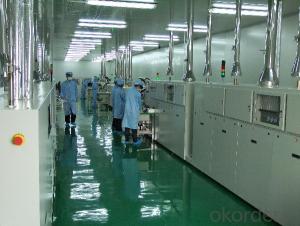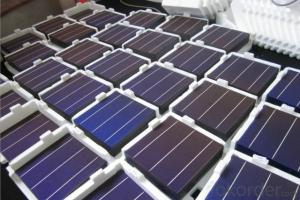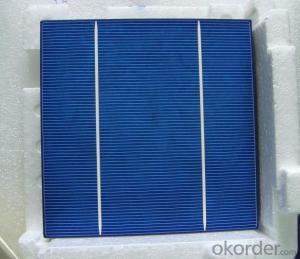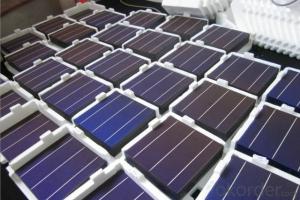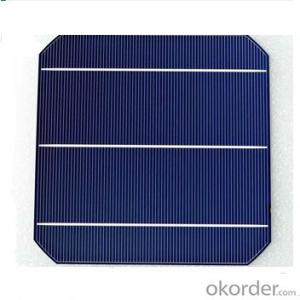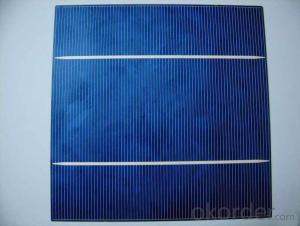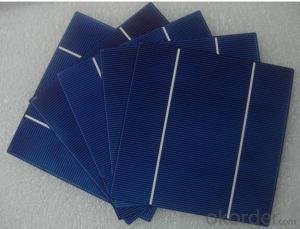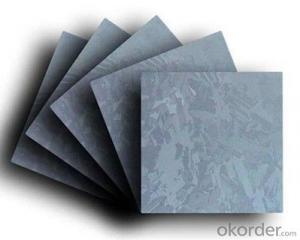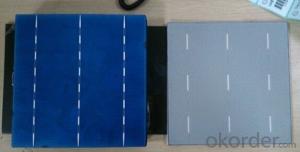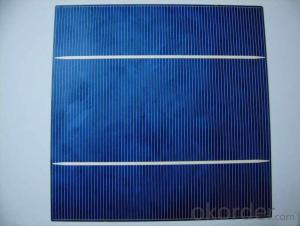High Current Solar Cell 16.8% Polycrystalline Silicon Solar Cell Price
- Loading Port:
- Shanghai
- Payment Terms:
- TT OR LC
- Min Order Qty:
- 1000 pc
- Supply Capability:
- 100000 pc/month
OKorder Service Pledge
OKorder Financial Service
You Might Also Like
4 Bus Bars 156*156 17.6% efficiency poly solar cell
PHYSICAL CHARACTERISTICS
Dimension: 156mm x 156mm ± 0.5mm
Wafer Thickeness: 180um+20um and 200um+20um
Front(-) Four 1.2mm silver busbar
Silicon nitride blue anti-reflection coating
Back(+) aluminum back surface field
1.75mm(silver) wide segment soldering pads
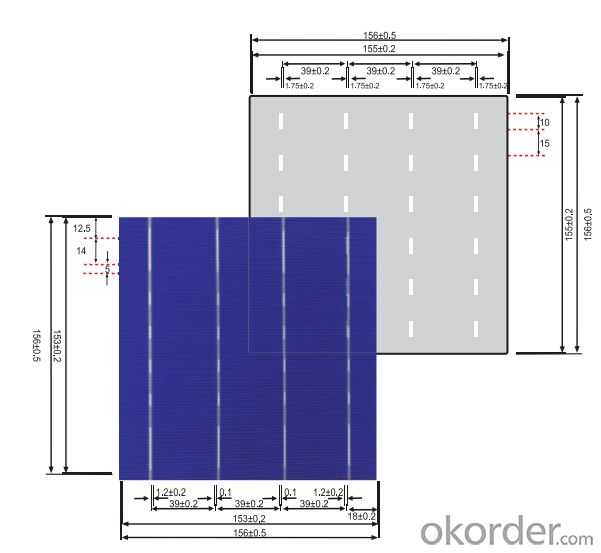
Typical Electrical Characteristics
Efficiency | W(Pmpp) | V(Umpp) | A(Impp) | V(Uoc) | A(Isc) |
17.4-17.5 | 4.234 | 0.517 | 8.231 | 0.622 | 8.759 |
17.5-17.6 | 4.259 | 0.519 | 8.243 | 0.623 | 8.769 |
17.7-17.8 | 4.283 | 0.521 | 8.256 | 0.625 | 8.779 |
17.8-17.9 | 4.307 | 0.523 | 8.268 | 0.626 | 8.788 |
17.9-18.0 | 4.332 | 0.525 | 8.281 | 0.627 | 8.798 |
18.0-18.1 | 4.380 | 0.529 | 8.306 | 0.629 | 8.808 |
18.1-18.2 | 4.405 | 0.531 | 8.318 | 0.632 | 8.818 |
18.2-18.3 | 4.429 | 0.533 | 8.331 | 0.633 | 8.837 |
18.3-18.4 | 4.453 | 0.535 | 8.344 | 0.634 | 8.847 |
18.4-18.5 | 4.478 | 0.537 | 8.356 | 0.636 | 8.856 |
18.5-18.6 | 4.502 | 0.539 | 8.369 | 0.637 | 8.866 |
Efficiency | W(Pmpp) | V(Umpp) | A(Impp) | V(Uoc) | A(Isc) |
20.90-21.00 | 5.06 | 0.557 | 9.007 | 0.653 | 9.688 |
20.80-20.90 | 5.04 | 0.556 | 9.062 | 0.652 | 9.683 |
20.70-20.80 | 5.02 | 0.554 | 9.055 | 0.651 | 9.684 |
20.60-20.70 | 4.99 | 0.552 | 9.033 | 0.651 | 9.672 |
20.50-20.60 | 4.97 | 0.550 | 9.002 | 0.650 | 9.673 |
20.40-20.50 | 4.94 | 0.548 | 9.012 | 0.649 | 9.674 |
20.30-20.40 | 4.92 | 0.546 | 9.009 | 0.649 | 9.655 |
20.20-20.30 | 4.89 | 0.543 | 9.012 | 0.648 | 9.634 |
20.10-20.20 | 4.87 | 0.541 | 8.998 | 0.648 | 9.617 |
20.00-20.10 | 4.85 | 0.540 | 8.977 | 0.647 | 9.600 |
*Data under standard testing conditional (STC):1,000w/m2,AM1.5, 25°C , Pmax:Positive power tolerance.
3 Bus Bars 156*156 17.4% efficiency poly solar cell
Dimension: 156 mm x 156 mm ± 0.5 mm
Wafer Thickeness: 156 mm x 156 mm ± 0.5 mm
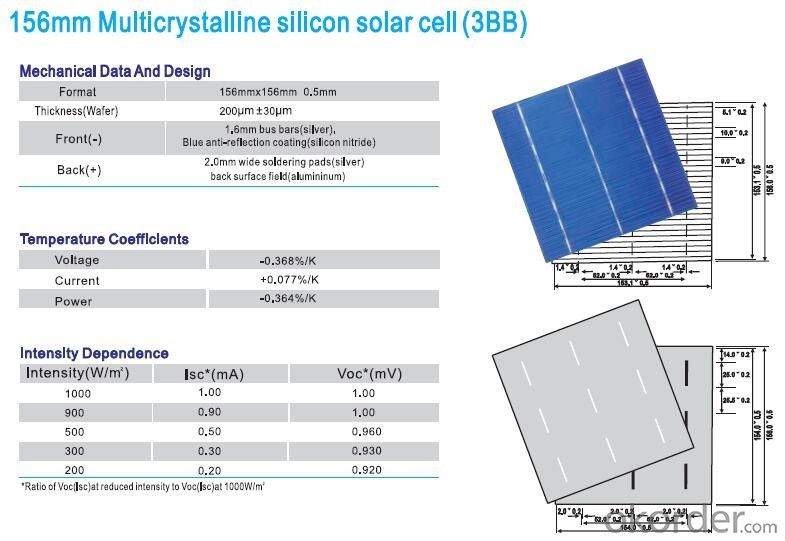
Typical Electrical Characteristics:
| Efficiency code | 1660 | 1680 | 1700 | 1720 | 1740 | 1760 | 1780 | 1800 | 1820 | 1840 | 1860 |
| Efficiency (%) | 16.6 | 16.8 | 17.0 | 17.2 | 17.4 | 17.6 | 17.8 | 18.0 | 18.2 | 18.4 | 18.6 |
| Pmax (W) | 4.04 | 4.09 | 4.14 | 4.19 | 4.23 | 4.28 | 4.33 | 4.38 | 4.43 | 4.48 | 4.53 |
| Voc (V) | 0.612 | 0.615 | 0.618 | 0.621 | 0.624 | 0.627 | 0.629 | 0.63 | 0.633 | 0.635 | 0.637 |
| Isc (A) | 8.42 | 8.46 | 8.51 | 8.56 | 8.61 | 8.65 | 8.69 | 8.73 | 8.77 | 8.81 | 8.84 |
| Imp (A) | 7.91 | 7.99 | 8.08 | 8.16 | 8.22 | 8.27 | 8.33 | 8.38 | 8.43 | 8.48 | 8.53 |
* Testing conditions: 1000 W/m2, AM 1.5, 25 °C, Tolerance: Efficiency ± 0.2% abs., Pmpp ±1.5% rel.
* Imin : at 0.5 V
Production:
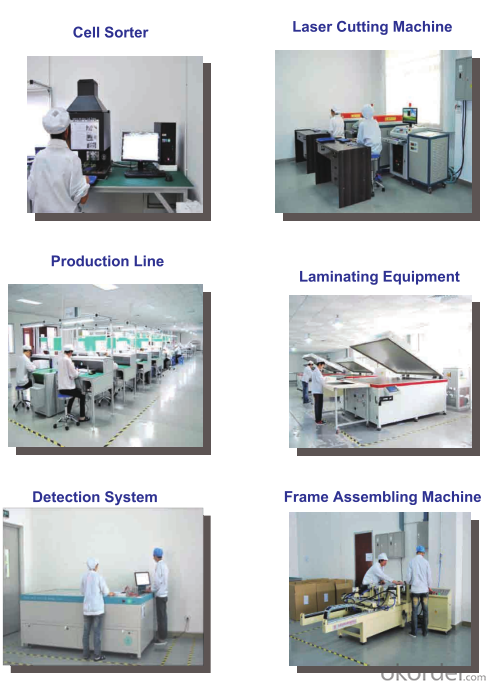
Package:
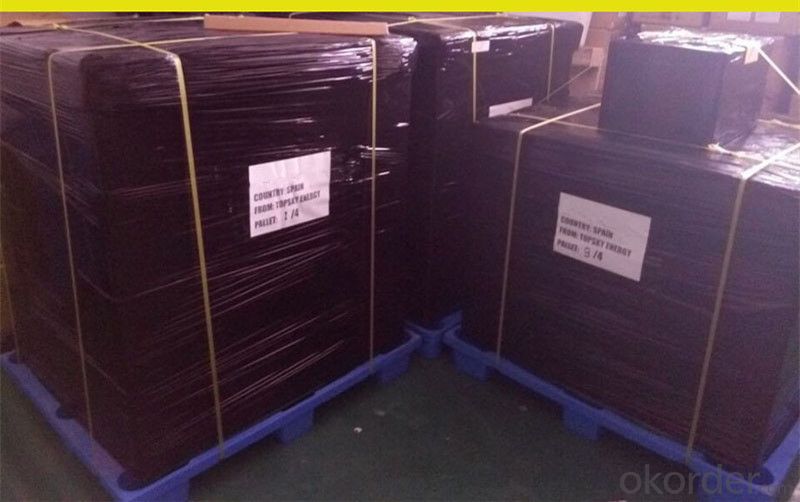
FAQ:
1. Q: Do you have your own factory?
A: Yes, we have. Our factory located in Jiangsu
2. Q: How can I visit your factory?
A: Before you visit,please contact us.We will show you the route or arrange a car to pick you up.
3. Q: Do you provide free sample?
A: Commenly we provide paid sample.
4. Q: Could you print our company LOGO on the nameplate and package?
A: Yes, we accept it.And need an Authorization Letter from you.
5. Q: Do you accept custom design on size?
A: Yes, if the size is reasonable.
6. Q: How can I be your agent in my country?
A: Please leave feedback. It's better for us to talk about details by email.
7. Q: Do you have solar project engineer who can guide me to install system?
A: Yes, we have a professional engineer team. They can teach you how to install a solar system.
- Q: How are solar silicon wafers cleaned before assembly into solar cells?
- Solar silicon wafers are cleaned before assembly into solar cells through a multi-step process. Firstly, the wafers are treated with a mixture of chemicals to remove any organic and inorganic impurities. Then, they undergo a thorough rinse to ensure complete removal of the cleaning solution. Next, the wafers are subjected to a drying process to eliminate any remaining moisture. Finally, a quality inspection is conducted to ensure the cleanliness of the wafers before they are assembled into solar cells.
- Q: What is the efficiency of a solar cell made with silicon wafers?
- The efficiency of a solar cell made with silicon wafers can vary, but on average, it ranges from 15% to 25%.
- Q: How are solar silicon wafers affected by light-induced degradation?
- Solar silicon wafers are affected by light-induced degradation as they experience a decrease in their photovoltaic performance over time due to prolonged exposure to sunlight. This degradation is primarily caused by the presence of impurities in the silicon material and the formation of defect states known as "traps" within the solar cells. These traps trap charge carriers, reducing the efficiency of the solar cells and leading to a decrease in their power output.
- Q: How are solar silicon wafers affected by humidity and moisture?
- Solar silicon wafers are negatively affected by humidity and moisture. The presence of water or high humidity can lead to the formation of corrosion, which can degrade the performance of the wafers and reduce their efficiency. Moisture can also cause the growth of molds, fungi, or other contaminants on the surface, further impacting the functionality of the wafers. Therefore, it is crucial to protect solar silicon wafers from excessive moisture and humidity to maintain their optimal performance and longevity.
- Q: What is the expected lifetime of a solar silicon wafer?
- The expected lifetime of a solar silicon wafer is typically around 25 to 30 years.
- Q: How is a microinverter integrated into a solar silicon wafer?
- A microinverter is not directly integrated into a solar silicon wafer. Instead, it is typically connected to the solar panels after the silicon wafer has been manufactured and made into a solar cell. The microinverter is then installed on the back of each individual solar panel, allowing for the conversion of the DC (direct current) power generated by the solar panel into AC (alternating current) power that can be used by the electrical grid or household appliances.
- Q: How is a tracker integrated into a solar silicon wafer?
- A tracker is typically not integrated directly into a solar silicon wafer. A solar tracker is a separate mechanical device that is used to orient the solar panels or arrays towards the sun. It allows the panels to follow the sun's movement throughout the day, maximizing their exposure to sunlight and increasing energy generation. The tracker is mounted onto the supporting structure of the solar panel system, and its movement is controlled by specialized motors or actuators. This integration ensures that the solar panels always face the sun at the optimal angle for maximum energy production.
- Q: How do solar silicon wafers perform in earthquake-prone environments?
- Solar silicon wafers perform well in earthquake-prone environments as they are designed to withstand vibrations and shocks. The wafers are typically mounted on sturdy frames or structures that are engineered to absorb and dissipate seismic forces. Additionally, solar panel installations in such regions undergo rigorous testing and adhere to strict building codes to ensure their resilience during earthquakes.
- Q: How do we use the scanning electron microscope
- After wiping with cotton wool, wash ear ball can be dried.Some of the words can be placed in alcohol solution ultrasonic cleaning, the effect is almost.
- Q: What is the role of light trapping in solar silicon wafers?
- The role of light trapping in solar silicon wafers is to enhance the absorption of sunlight by increasing the path length of light within the wafer. This allows for a greater amount of light to be absorbed, resulting in improved efficiency of the solar cell.
Send your message to us
High Current Solar Cell 16.8% Polycrystalline Silicon Solar Cell Price
- Loading Port:
- Shanghai
- Payment Terms:
- TT OR LC
- Min Order Qty:
- 1000 pc
- Supply Capability:
- 100000 pc/month
OKorder Service Pledge
OKorder Financial Service
Similar products
Hot products
Hot Searches
Related keywords
